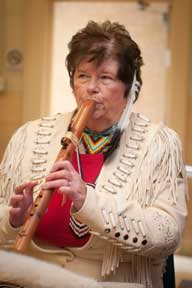
 CHARLESTON—Drums, flutes, song, prayer and the sweet smell of sage were used to honor St. Kateri Tekakwitha, the first Native American saint, on Dec. 1 at Blessed Sacrament Church.
CHARLESTON—Drums, flutes, song, prayer and the sweet smell of sage were used to honor St. Kateri Tekakwitha, the first Native American saint, on Dec. 1 at Blessed Sacrament Church.
About 100 people attended a Mass, celebrated by Bishop Robert E. Guglielmone, and a heritage celebration that followed. The event was sponsored by the diocesan Office of Ethnic Ministries.
St. Kateri was beatified by Pope John Paul II in 1980 and officially canonized by Pope Benedict XVI on Oct. 21. 
Known as “the Lily of the Mohawks,” she was born in upstate New York in 1656. Her father was Mohawk and her mother an Algonquin Catholic.
Her family died in a smallpox epidemic, and she was raised by an uncle. Kateri eventually moved to Canada because members of her tribe were hostile to her faith. There she spent her days in prayer, attending Mass, and caring for the poor, elderly and sick.
She died in 1680 at the age of 24, and tradition says that after her death, her face, scarred by smallpox, became smooth and beautiful again.
Many miracles are attributed to her and passed down through stories over the generations, but the final one that assured her sainthood was a boy’s healing from a flesh-eating skin disease after he touched one of her relics.
In his homily, Bishop Guglielmone said he has known about Kateri since childhood.
“There was no possible way you go through Catholic education in New York and not hear about Kateri and the difficulties she endured that never daunted her faith,” he said. “She is one of those saints who did very simple things in a loving way. She reached out to those who had no one to care for them, and shared her wonderful faith in Jesus Christ.”
During the celebration, Simpsonville artist Melanie Creeping Fox Riddle displayed paintings from “The Miracle Project,” a series on St. Kateri Tekakwitha’s life. Riddle is a member of the Lower Eastern Cherokee Nation and attends Our Lady of the Rosary Church in Greenville.
“I learned to feel a real connection with her by doing these paintings,” she said. 
 Chief Gene Norris of the Lower Eastern Cherokee Nation, based in Laurens, said the event was a time for people to reflect not only on their heritage, but the importance of faith.
Chief Gene Norris of the Lower Eastern Cherokee Nation, based in Laurens, said the event was a time for people to reflect not only on their heritage, but the importance of faith.
“Kateri’s life teaches us to have a lot of prayer in our daily life,” he said. “Prayer always helps.”
The Charleston event drew many members of the Warrior Creek Kateri Circle in the Upstate, including Mary Louise Worthy of Laurens, vice chief for the Lower Eastern Cherokee.
“St. Kateri is someone all Native Americans can appreciate, no matter what tribe you’re affiliated with,” Worthy said. “I’m hoping her canonization will draw more Native American Catholics to our events and help make them more active.”
Miscellany photos by Douglas Deas
